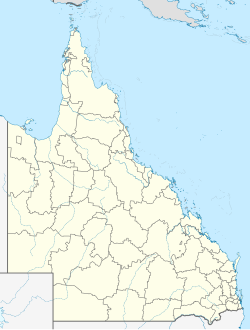Wharf Street Congregational Church, Brisbane
| Wharf Street Congregational Church | |
|---|---|

Wharf Street Congregational Church
|
|
| 27°27′52.5″S 153°01′46.15″E / 27.464583°S 153.0294861°ECoordinates: 27°27′52.5″S 153°01′46.15″E / 27.464583°S 153.0294861°E | |
| Location | Wharf Street, Brisbane, Queensland |
| Country |
|
| History | |
| Founded | 1860 |
The Wharf Street Congregational Church was a Congregational church built in 1860 on the corner of Wharf Street and Adelaide Street, Brisbane, Queensland, Australia. The church was demolished in 1928. It was the first Congregational church in Brisbane.
It is believed that the first Congregationalists arrived on the Fortitude on 21 January 1849, being the first of three ships of free immigrants sent to this district by the Rev. Dr. John Dunmore Lang, whose advice to the immigrants was to combine for Christian fellowship and worship rather than establish separate denominations. In March 1850, the United Evangelical Church was created, combining those of Presbyterian, Baptist, and Congregational beliefs, under the ministry of the Rev. Charles Stewart (chaplain of the Fortitude).
At first the congregation worshipped in the courthouse, but later purchased land fronting William and George Streets (in 2010 the Lands Office building occupies the site) and erected a brick church. However, while a united church served their early needs, the Baptists desired to have their own church and the united church was sold for £1500 and the proceeds divided between the three denominations, providing the basis for establishing three separate churches: Wharf Street Congregational, Wharf Street Baptist and Creek Street Presbyterian.
In 1858 the Rev. George Wight arrived at Brisbane from Edinburgh. He had been sent by the London Colonial Missionary Society to establish a Congregational Church in Brisbane. However, his immediate challenge was to find a venue for the congregation to meet for worship. He wrote of this period: "One of the difficulties that met us at the threshold was the impossibility of procuring, on any terms whatever, a proper place for holding meetings. There was only one place in the town (the hall of the School of Arts) where a hundred people could be comfortably accommodated and that was occupied by the Presbyterian congregation under the charge of the Rev.C. Ogg. We were therefore, fain to occupy a rickety loft—Mr. Binney called it facetiously an 'upper room' —reached by a rickety trap ladder, and used on week days as a schoolroom. The dilapidated wood building overhung a dark, sluggish creek, which meandered through the centre of the town, and after tropical showers the approach to it was almost impassable."
In 1859 the Rev. T. Bell, pastor of the United Presbyterian Church, died, and the building he had occupied was rented for a time for use for Congregational meetings. Meanwhile, funds were being raised to add to the £500 received from the sale of the united church property.
...
Wikipedia

